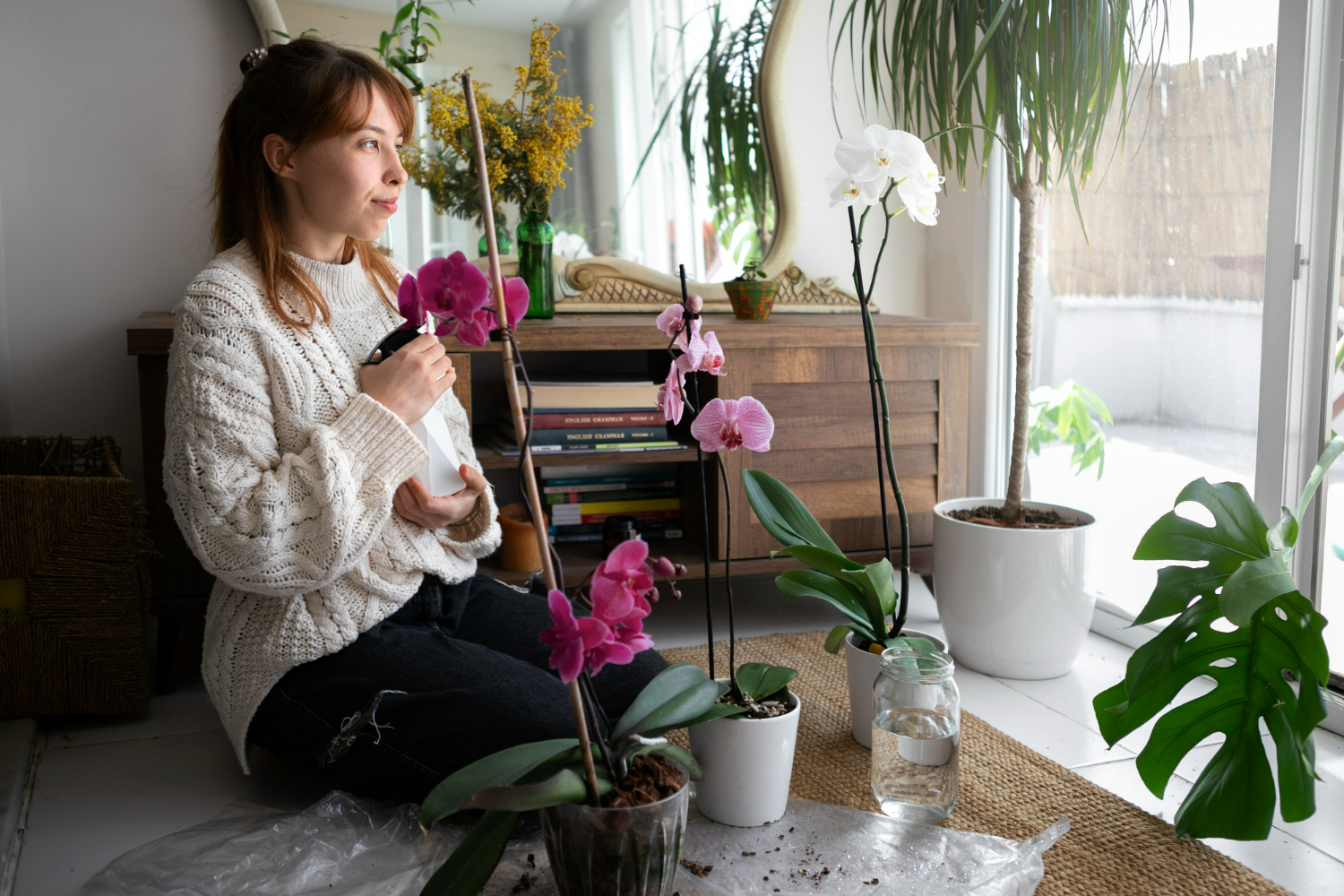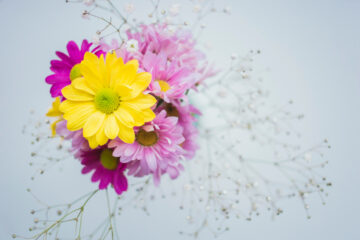Transform your home into a year-round blooming paradise with this comprehensive guide to indoor flower gardening. Learn how to select, grow, and care for top indoor flowers suited to various light conditions. Discover low-light options like peace lilies and snake plants, and bright-light favorites such as orchids and hibiscus. The guide offers tips on proper watering, humidity, temperature, soil, and fertilization to keep your plants thriving. Additionally, explore creative display ideas and understand the health benefits of indoor plants, from air purification to stress reduction. Embrace the joy of indoor gardening and enhance your living space with vibrant blooms.
Table of Contents
ToggleLow-light flowers:
- Peace lily (Spathiphyllum):
- Elegant white spathes and glossy dark green leaves
- Thrives in low to moderate light
- Excellent air purifier, removing benzene, formaldehyde, and other toxins
- Water when the top inch of soil feels dry
- Tolerates occasional overwatering better than most plants
- Snake plant (Sansevieria):
- Upright, sword-like leaves with variegated patterns
- Extremely tolerant of low light conditions
- Produces small, fragrant flowers on rare occasions
- Drought-tolerant; water sparingly
- Known for converting CO2 to oxygen at night, ideal for bedrooms
- ZZ plant (Zamioculcas zamiifolia):
- Glossy, dark green leaves on arching stems
- Highly tolerant of low light and neglect
- Rarely flowers indoors, but when it does, produces small, inconspicuous blooms
- Allow soil to dry completely between waterings
- Stores water in its rhizomes, making it incredibly drought-resistant
Bright-light flowers:
- Orchids (various genera, including Phalaenopsis and Dendrobium):
- Exotic, long-lasting blooms in a variety of colors and patterns
- Prefer bright, indirect light
- Water thoroughly when potting medium is nearly dry
- Require high humidity; benefit from pebble trays or regular misting
- Feed with specialized orchid fertilizer during growing season
- Hibiscus (Hibiscus rosa-sinensis):
- Large, trumpet-shaped flowers in vibrant colors
- Needs at least 6 hours of direct sunlight daily
- Keep soil consistently moist but not waterlogged
- Prune regularly to maintain shape and encourage bushiness
- Feed with a high-potassium fertilizer to promote blooming
- Geraniums (Pelargonium):
- Clusters of red, pink, or white flowers above fragrant foliage
- Thrive in bright light, including some direct sun
- Allow soil to dry slightly between waterings
- Deadhead regularly to promote continuous blooming
- Pinch back growing tips to encourage bushiness
Flowering plants for beginners:
- African violets (Saintpaulia):
- Compact plants with velvety leaves and delicate flowers
- Prefer bright, indirect light
- Water from the bottom to avoid leaf spotting
- Maintain high humidity with pebble trays or by grouping plants
- Use specialized African violet potting mix and fertilizer
- Kalanchoe (Kalanchoe blossfeldiana):
- Succulent with clusters of small, brightly colored flowers
- Thrives in bright, indirect light
- Allow soil to dry completely between waterings
- Flowers last for several weeks; deadhead to encourage reblooming
- Susceptible to overwatering; use well-draining soil
- Anthurium (Anthurium andraeanum):
- Heart-shaped, waxy flowers in bold reds and pinks
- Prefers moderate to bright indirect light
- Keep soil consistently moist but not soggy
- Benefits from high humidity; mist regularly or use a pebble tray
- Clean leaves periodically to maintain their glossy appearance
Growing Tips for Indoor Flowers
Light: Understanding your home’s light conditions is crucial for successful indoor gardening. Most flowering plants need bright, indirect light for 6-8 hours daily. Here’s a quick guide:
- South-facing windows: Brightest light, ideal for sun-loving plants like hibiscus and geraniums
- East or west-facing windows: Moderate light, perfect for orchids and African violets
- North-facing windows: Low light, suitable for peace lilies and snake plants Use sheer curtains to diffuse harsh direct sunlight and prevent leaf burn.
Water and humidity: Proper watering is often the trickiest aspect of indoor plant care. As a general rule:
- Water thoroughly when the top inch of soil feels dry
- Ensure pots have drainage holes to prevent waterlogging
- Use room temperature water to avoid shocking plant roots
- Increase humidity by misting, using pebble trays, or running a humidifier
- Group plants together to create a microclimate with higher humidity
Temperature: Most indoor flowers thrive in temperatures between 60-75°F (15-24°C). Be mindful of the following:
- Avoid placing plants near drafts from windows or air conditioning vents
- Keep them away from heat sources like radiators or fireplaces
- Some plants, like orchids, benefit from a slight temperature drop at night to trigger blooming
Soil and fertilization: The right potting mix and proper nutrition are essential for healthy, blooming plants:
- Use a well-draining potting mix appropriate for your specific plant
- Fertilize monthly during the growing season (spring and summer) with a balanced, water-soluble fertilizer
- Reduce or stop fertilization during winter months when growth slows
- Flush the soil every few months with plain water to prevent salt buildup
Pruning and maintenance: Regular grooming keeps your plants healthy and encourages better flowering:
- Deadhead spent blooms promptly to redirect energy to new growth and flowers
- Pinch back growing tips to promote bushiness and prevent legginess
- Remove yellowing or dead leaves to maintain plant health and appearance
- Clean leaves periodically with a damp cloth to remove dust and improve photosynthesis
Common Challenges and Solutions
Pest control: Indoor plants can fall victim to various pests. Here’s how to combat common invaders:
- Aphids: Treat with insecticidal soap or neem oil, or remove with a strong spray of water
- Spider mites: Increase humidity and treat with miticide or neem oil
- Mealybugs: Remove with cotton swabs dipped in rubbing alcohol, then treat with insecticidal soap
- Scale: Scrape off with a soft brush, then apply horticultural oil Regularly inspect your plants, paying close attention to leaf undersides and stem joints.
Diseases: Fungal and bacterial issues can plague indoor plants. Prevention is key:
- Ensure good air circulation by spacing plants properly
- Avoid overwatering and water at the base of the plant, not on leaves
- Remove affected parts immediately if disease occurs
- Use sterile tools when pruning to prevent spread of pathogens Common issues include powdery mildew, root rot, and leaf spot diseases.
Inadequate blooming: If your plant isn’t flowering as expected, consider these factors:
- Light exposure: Most flowering plants need bright light to bloom
- Fertilization: Use a bloom-boosting fertilizer high in phosphorus
- Pruning: Some plants bloom on new growth, so regular pruning can encourage flowering
- Temperature: Some plants, like orchids, need temperature fluctuations to trigger blooming
- Age: Some plants need to reach a certain maturity before they’ll bloom
Creative Display Ideas
Elevate your indoor garden with these innovative display techniques:
- Hanging planters:
- Perfect for trailing plants like string of pearls, fuchsias, or trailing begonias
- Use macramé hangers for a boho look, or sleek metal planters for a modern aesthetic
- Hang at varying heights to create visual interest and maximize vertical space
- Vertical gardens:
- Install wall-mounted planters or pocket planters for a living wall effect
- Use a variety of plants with different textures and colors for visual impact
- Consider self-watering systems for easier maintenance
- Windowsill arrangements:
- Group small pots of varied heights and sizes for an appealing display
- Mix flowering plants with foliage plants for contrast
- Use decorative pebbles or moss to cover soil and add visual interest
- Terrariums:
- Create miniature ecosystems with moisture-loving plants like ferns, mosses, and miniature orchids
- Use activated charcoal in the substrate to keep the environment fresh
- Choose an appropriate container based on the humidity needs of your chosen plants
- Plant shelves:
- Install floating shelves or use a bookshelf to create a stunning plant display
- Arrange plants of varying sizes, with larger plants on lower shelves and smaller ones higher up
- Incorporate grow lights on shelves for plants with higher light requirements
Health Benefits of Indoor Flowers
The benefits of indoor plants extend far beyond their aesthetic appeal:
- Air purification:
- Many flowering plants excel at removing indoor air pollutants
- Chrysanthemums and gerbera daisies are particularly effective at removing benzene
- Peace lilies and anthuriums help reduce levels of ammonia
- Stress reduction:
- Studies show that the presence of plants can lower cortisol levels and blood pressure
- The act of caring for plants can be a meditative, stress-relieving activity
- Natural scents from flowers like lavender and jasmine have calming properties
- Improved productivity and mood:
- Research indicates that flowers in workspaces can enhance creativity and job satisfaction
- The color green has been shown to improve reading ability and creativity
- Plants in hospital rooms have been linked to faster recovery times and reduced need for pain medication
- Better sleep:
- Some plants, like lavender and jasmine, can improve sleep quality when placed in bedrooms
- Plants that convert CO2 to oxygen at night, like orchids and succulents, can improve air quality for better sleep
Seasonal Considerations
Adapting your care routine to the changing seasons is crucial for year-round plant health:
Winter care:
- Reduce watering frequency as growth slows and humidity decreases
- Stop or greatly reduce fertilization
- Provide supplemental lighting if natural light decreases significantly
- Move plants away from cold windows and drafty areas
- Consider using a humidifier to combat dry indoor air from heating systems
Summer adjustments:
- Increase watering frequency to combat higher temperatures and increased evaporation
- Mist plants regularly or use pebble trays to increase humidity
- Protect plants from harsh afternoon sun by moving them or using sheer curtains
- Fertilize more frequently during this active growing period
- Monitor for pests more vigilantly, as many insects thrive in warm conditions
In conclusion, cultivating an indoor flower garden is a rewarding endeavor that brings nature’s beauty and benefits into your home. By selecting the right plants for your environment, following proper care techniques, and adapting to seasonal changes, you’ll enjoy a flourishing indoor oasis that delights the senses and nurtures well-being. Remember, each plant is unique, so observe your flowers closely and adjust care as needed. With patience and attention, you’ll develop a thriving indoor garden that provides joy and beauty year-round. Happy gardening! CopyRetry





